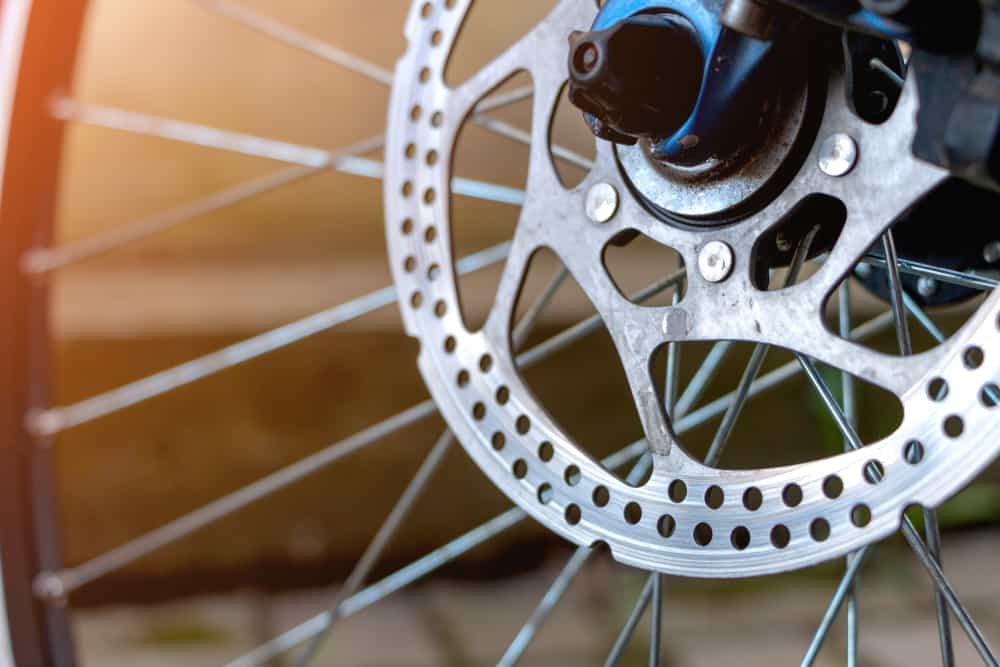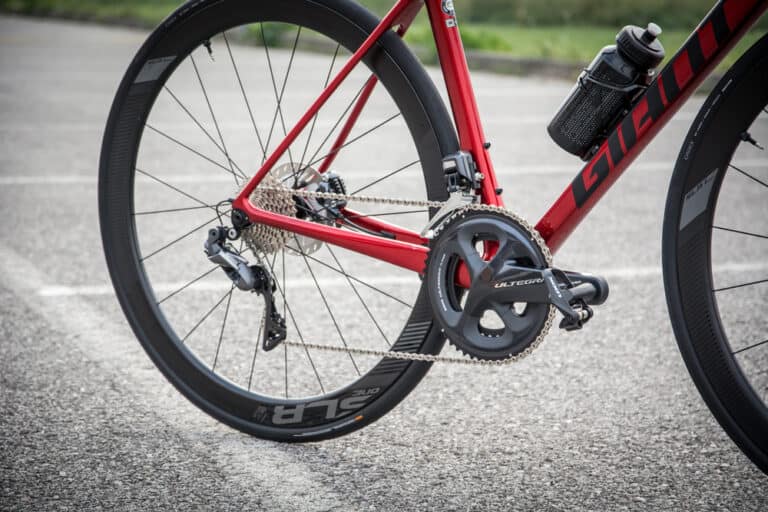How Much Does It Cost To Convert A Bike To Disc Brakes?

Bicycle brakes have come a long way in the last fifty years, and the modern systems which can be installed often emulate those found on motor vehicles. The latest versions of disc brakes include high-end hydraulic systems which the cyclist can maintain.
To convert an existing rim-based bicycle braking system with a disc brake system active on the front and rear wheels will cost between $25.00 to $150.00. The final price you will pay will depend on whether you choose a lower-cost mechanical system or a hydraulic unit.
If you have an existing rim brake system on your bicycle, converting it to a disc brake system is worthwhile and can be achieved relatively low cost. You will need to decide whether to maintain a mechanical cable system or convert to a full-blown hydraulic braking setup.
How Much It Costs To Convert A Bike To Disc Brakes?
There are so many variations of disc braking conversion systems and kits available to cyclists that it is impossible to quote a single fixed price.
The systems vary from simple cable-controlled, mechanically activated units to advanced hydraulically operated systems which replace the standard brake cable with hydraulic lines.
The mechanical disc braking kits cost between $25.00 to approximately $50.00. Some examples of mechanical disc brakes on Amazon include the following products
- BlueSunshine MTB BB8 Mechanical brakes kit – $24.99 (Available on Amazon below).
- DEYING Zoom MTB Mountain Bike Mechanical Disc Brake – $49.99 (Available on Amazon below).
Hydraulic units range in price from $55.00 to well over $150.00. Several examples of hydraulic disc brake kits include the following.
- WIROJ Mountain Bike Hydraulic Disc Brake Set – $54.99 (Available on Amazon below).
- DEYING Zoom Bike Bicycle Cycling HB-100 Hydraulic Disc Brake – $79.99 (Available on Amazon below).
- JGbike Shimano MT200 MTB Hydraulic Disc Brake Set for Mountain Bike $119.99 – $149.99 (Available on Amazon below).
While the costs may seem high, the benefits over a conventional rim-based wheel braking system are significant. The added safety, reliability, and ease of use make it a worthwhile investment.
What Are the best brakes for a bicycle?
There are three braking systems available for bicycles, as follows.
- Rim brakes
- Drum brakes
- Disc brakes
Rim Brakes On A Bicycle
Rim brakes have been the standard issue braking systems on bicycles for many years.
Rim brakes work with calipers installed on either side of the wheel onto which two rubber braking pads are attached.
When the handlebar brake lever is squeezed, the calipers close and tighten the two rubber braking pads on each side of the wheel rim, causing friction and slowing the rotational speed of the bike’s wheel.
Drum Brakes On A Bicycle
A drum brake consists of a drum mounted on the wheel axle.
There are two brake shoes fitted on opposite sides Inside the drum. The two shoes remain stationary as the drum rotates around them. The two shoes are attached to levers, which are attached via a cable to the brake lever on the handlebars.
When the brake lever, which is positioned on the handlebar, is squeezed, the two levers on the brake drum are activated, which activates a cam that pulls the brake shoes towards the outer edge of the moving drum and creates friction on the drum, thereby slowing the rotational speed of the bike’s wheel.
The effectiveness of a hub brake depends on the diameter of the drum or disc. A small-diameter brake is generally weaker and has poorer heat dissipation.
Disc Brakes On A Bicycle
Disc brakes on a bicycle consist of a brake disc mounted on the axle of the bicycle wheel.
Two brake pads are attached to calipers on either side of the disc, which are connected to the brake lever on the handlebars.
As the brake lever is squeezed closed, the calipers push the two brake pads towards each other (on either side of the brake disc) and so create friction on the brake disc, which slows the rotation of the wheel.

How Do The Three Different Braking Systems Compare?
The following lists the comparisons of each braking system.
| Rim Brakes | Drum Brakes | Disc Brakes | |
|---|---|---|---|
| Wear rate | Rim brakes are prone to high wear rates. When being ridden over sand and mud, they can also cause wear to the bicycle rim. | Drum brakes have a low wear rate and generally exhibit good longevity | Depending on the material from which the brakes pads are made, disc brakes have a low wear rate and generally exhibit good longevity |
| Operation in water | Inadequate become unusable in wet conditions | Excellent no degradation | Better than rim brakes, but in extremely wet conditions, there may be some degradation. |
| Propensity for damage | Rim brakes are exposed to damage and ate the most vulnerable of the three types. | Very little chance of being damaged because the working parts are not visible | The disc is exposed and therefore is at risk of damage |
| Can they be used with tick tires? | No | Yes | Yes |
| Maintenance Requirements | Require maintenance | Require minimal maintenance | Require maintenance |
| Ease of replacement | Very simple | Very difficult as the drum is often mounted as an integral part of the wheel hub, which involves removing the reaction arm while the cable must be disconnected and reconnected | Brake shoes can be replaced when worn, |
| Braking action | The least sensitive braking action and the most difficult to modulate | The easiest action to modulate and make fine braking corrections | Disc brake modulation is superior to rim brakes and similar to drum brakes |
| Brake system weight | Rim braking systems are generally the lightest option | Hub brakes are generally heavier than rim brakes. | Disc brakes are not excessively heavy. |
| Torque Steering | Minimal impact on steering | Unless the front fork is very stiff, and if the drum brake is only installed on one side of the wheel, the torque generated by a drum brake may cause steering issues. | Minimal impact on steering, particularly if twin disc brakes are used (one on each side) |
| Ease of replacement | Most rim brake pads are interchangeable and not manufacturer specific | There is minimal interchangeability with drum brakes, and the components which make up the drum brakes are generally manufacturer specific. | Most disc brake components are interchangeable between manufacturers. |
| Generals Disadvantages | Rim brakes are vulnerable to damage to the wheel rim and could become inoperable if the wheel rim is bent or out of true. | Drum brakes can sometimes stick and not release after the bicycle has been brought to a stop. | The external rotor is vulnerable to getting warped or bent. |
Conclusion
For between $25,00 to $150.00, it is possible to install several different varieties of disc brakes on a bicycle. The advantages that disc brakes offer make conversion cost a worthwhile investment.
The only decision that will need to be made is whether to choose a disc braking system or convert it to a drum braking system, both of which have unique advantages and disadvantages.












